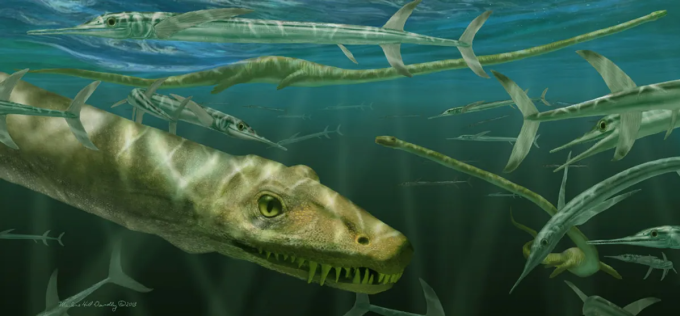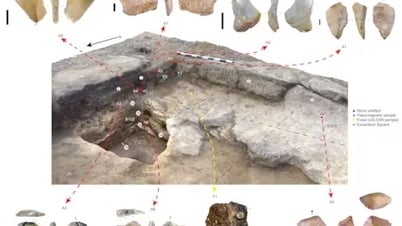The marine reptile known as the Chinese dragon has a 2.3 meter long neck with 32 cervical vertebrae, helping it ambush prey underwater.

Dinocephalosaurus orientalis fossil with a long neck. Photo: National Museums Scotland
Scientists have revealed impressive fossils of an ancient marine reptile discovered in China, Live Science reported on February 23. The animal lived 240 million years ago and was dubbed the "Chinese dragon", its scientific name Dinocephalosaurus orientalis . It used its exceptionally long neck to ambush prey in shallow waters during the Triassic period (252 million to 201 million years ago).
The Chinese dragon was first discovered in limestone quarries in southern China in 2003, but scientists were unsure of its shape because the fossils were incomplete. Now, new fossils have been discovered and pieced together to fully reconstruct the ancient carnivore's 5-meter-long body. The new study appears in the journal Earth and Environmental Science: Transactions of the Royal Society of Edinburgh.
“This is another example of the weird and wonderful world of the Triassic that continues to baffle palaeontologists. We are sure it will delight the world with its striking appearance, reminiscent of the mythical Chinese dragon – a long, snake-like creature,” said Nick Fraser, curator of natural sciences at National Museums Scotland.

Illustration of a "Chinese dragon" swimming with some ancient fish. Photo: Marlene Donelly
The fossils reveal some of the highlights of the ancient marine reptile. Most impressive is its nearly 2.3 meter long neck with 32 separate vertebrae, while giraffes (like humans) only have 7 neck vertebrae.
The Chinese dragon’s multi-segmented, snake-like neck may have helped it to close in on prey efficiently and strike. Fossils of several fish have been preserved in the sea monster’s stomach. It also had serrated teeth and flipper-like limbs. Despite its aquatic life and long, slender neck, the Chinese dragon is not closely related to the pterosaur, which evolved about 40 million years later and may have inspired the Loch Ness Monster.
"We hope that future studies will help us understand more about the evolution of this group of animals, especially how their long necks worked," said team member Stephan Spiekman, a postdoctoral fellow at the Stuttgart State Museum of Natural History.
Thu Thao (According to Live Science )
Source link














































































































Comment (0)